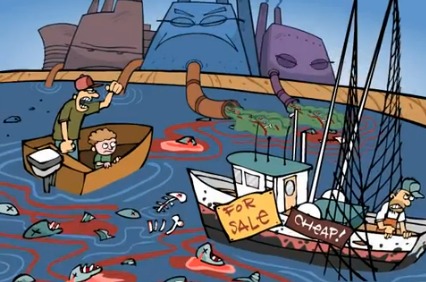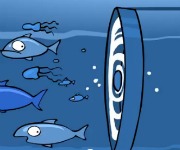 Watch the process demonstrated in an animation by Pulitzer Prize-winning cartoonist Mark Fiore.Giant fish blenders: It may sound like a workaday instrument at the Food Network, but it’s actually a very real threat. Power plants are killing fish and damaging our waterways via their outdated once-through cooling systems. We can help, but we need to act fast: The deadline for action to remedy this situation is Thursday, Aug. 18!
Watch the process demonstrated in an animation by Pulitzer Prize-winning cartoonist Mark Fiore.Giant fish blenders: It may sound like a workaday instrument at the Food Network, but it’s actually a very real threat. Power plants are killing fish and damaging our waterways via their outdated once-through cooling systems. We can help, but we need to act fast: The deadline for action to remedy this situation is Thursday, Aug. 18!
Let me explain what we mean by “giant fish blenders.” Antiquated power plants (many of them coal-fired power plants) throughout the nation use water intake structures to help cool systems that generate heat during the energy-making process. These pipes sit below the water’s surface and suck in water and anything else in the vicinity. This process shreds and destroys any aquatic life drawn in.
After the water is drawn through the power plant, it is discharged at an elevated temperature back into the waterbody, causing even more damage. The process affects the full spectrum of wildlife in the aquatic ecosystem at all life stages — from tiny photosynthetic organisms to fish, shrimp, crabs, birds, and marine mammals. Some areas face devastating economic impacts as fisheries are threatened and recreational uses are diminished.
The amount of water used by these power plants is staggering: Collectively, steam-electric power plants have the capacity to withdraw more than 370 billion gallons per day in the U.S. — more than 135 trillion gallons per year — from our nation’s waters for cooling. This accounts for 49 percent of all water use. That’s more water than all irrigation and public water supplies combined in the U.S.
Unfortunately, instead of stopping these giant fish blenders (aka power plants), the EPA bowed to intense pressure from powerful industry interests. The EPA has decided not to require power plants to use the best technology available; instead they issued a proposed standard that largely maintains the status quo, offering little-to-no improvement in the technologies required to protect our waterways and our wildlife.
But there’s a solution. Closed-cycle cooling is the best technology available to reduce the impacts of cooling water systems and is both cost-effective and already in use across the country. Closed-cycle cooling reduces water intakes by approximately 95 percent, drastically reducing the amount of water needed for power plant operations, and resulting in much less impact on fish and other species and the surrounding ecosystem.
But the guidelines currently proposed by the EPA will do little to address the devastation described in our recently released report “Giant Fish Blenders: How Power Plants Kill Fish & Damage Our Waterways (And What Can Be Done to Stop Them.” We hope that the report will illuminate the harmful effects of once-through cooling on the health of our fisheries and waterways, and will encourage the EPA to require higher standards for these systems.



